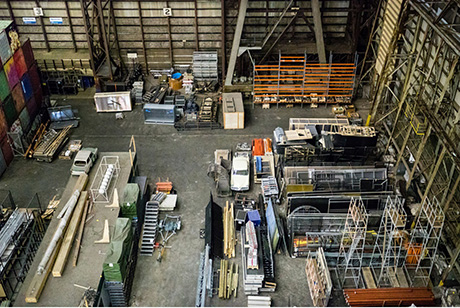Lee & Associates’ 2024 Q4 North America Market Report looks back at the tenant demand, absorption rates and vacancy trends for industrial, office, retail and multifamily sectors nationwide to extrapolate what might be on the horizon for 2025 and beyond. While net absorption in industrial and retail is down from the same period in 2023, the reasons — too much supply in the pipeline versus too little — are opposite for each sector. Similar mirroring due to reverse factors can be seen in the net positive absorption last quarter in office and multifamily.
Net industrial absorption was down 45 percent in the last quarter of 2024, compared to the same quarter in 2023. However, vacancy rates are likely to decline this year due to a lower volume of construction starts completing in 2025.
New in-office policies among prominent companies contributed to the office market’s second consecutive quarter of positive absorption, but overall, office vacancy numbers are expected to continue rising until 2026.
Low vacancy and factors challenging development meant very few options for retail tenants seeking new, high-quality space. Retail tenants in the food and beverage arena have been taking advantage of increased national spending on food outside the home — these spaces accounted for nearly 20 percent of all leasing activity over 2024.
The multifamily construction boom of the last two years has been met by exceptional demand in the space. Sunbelt rent growth is slowing or declining, while Midwest and Northeast rent growth has remained resilient due to slower growth during the start of the decade.
Lee & Associates’ full market report is available to read here (the report contains complete breakdowns of cap rates by city, market rents, vacancy rates, square footage information and more). The detailed recaps for industrial, office, retail and multifamily sectors below indicate what trends the market can expect this year and beyond.

Industrial Overview: Dockworkers Strike Threat, Tariff Questions Slow Demand
Tenant demand for industrial space in the United States fell sharply in 2024 and rent growth was the weakest in more than a decade. Several factors were behind the slowdown. Business owners paused expansions in 2023 largely due to lingering supply-chain issues and higher interest rates that reduced home sales and purchases of home improvement materials and appliances. In the United States, a potential longshoremen strike threatened East Coast shipping and caution continued to hobble growth plans in 2024 pending the general election and its effect on tariffs.
Fourth-quarter net absorption in the United States totaled 37 million square feet, down 45 percent from the same period in 2023. For the year, net absorption totaled 113.7 million square feet, off 36 percent from 2023.
As long as net absorption can remain marginally positive, vacancy increases will likely slow in 2025 as the volume of speculative developments completing construction is set to abate. The continued reduction in industrial construction starts that occurred in late 2024 also raises the probability that the U.S. vacancy rate could begin to decline by late 2025 or early 2026.
In the meantime, year-over-year rent growth has slowed to 2.1 percent, the slowest level since 2012. Thanks to record rent growth during the pandemic, many leases are still renewing at more than 40 percent higher rates after being marked to market. However, this is much more easily achieved in the small building segment of the market, where vacancy remains less than 4 percent and near pre-COVID record lows. In contrast, the stock of logistics properties 100,000 square feet or larger has grown by 20 percent over the past four years and the vacancy rate among these buildings has surpassed 9 percent, hitting the highest level since 2012.
Abundant distribution center closures by third-party logistics firms contributed to the soft quarter with UNIS, DHL and Pitney Bowes each closing more than one large facility in the final months of the year. Retailers and manufacturers selling goods such as furniture and building materials also continue to be negatively impacted by higher mortgage rates. During the fourth quarter, Big Lots closed a 3.9-million-square-foot facility in Columbus serving as its corporate headquarters and largest distribution center. Malouf, a luxury mattress maker, closed a 1.2 million-square-foot facility in Bakersfield and Home Depot vacated a 990,000-square-foot distribution facility that it listed for sublease in Chicago’s Joliet submarket.
While new deliveries have peaked, several Sunbelt and Midwest markets with fewer constraints on new development are still in the midst of a record supply wave that could take tenants more than two years to fully absorb. Austin, Indianapolis, Greenville/Spartanburg, Phoenix and San Antonio stand out as markets with risks of prolonged higher availability rates, particularly among larger industrial properties as developers have been focused on building projects 50,000 square feet or larger in recent years.

Office Overview: Market Stabilizing, Workers Return
The North American office market is approaching an inflection point with an apparent assist from employers revising permissive pandemic workplace policies. Tenant demand in the United States closed 2024 by posting a second straight quarter of growth.
U.S. net absorption was 3.5 million square feet in the fourth quarter of 2024 and totaled 11.2 million square feet for the second half with premium Class A space most in demand. Nearly half the nation’s top 50 office markets have seen positive demand since the second quart of 2024, led by New York City. Some secondary and most tertiary markets have also seen resurgent demand. But there are several gateway cities and many secondary markets that continue to lose occupancy to slow job growth and reduced space requirements post-COVID.
Nearly 23 million square feet of negative absorption in the first quarter of 2024 brought the cumulative loss since the onset of COVID-19 to 206 million square feet. By comparison, absorption losses associated with the Great Recession of 2008-09 totaled about 50 million square feet.
A number of companies have increased worker attendance requirements or plan to do so, including Disney, Starbucks, X and Amazon, whose CEO, Andy Jassy, said: “When we look back over the last five years, we believe the advantages of being together in the office are significant.” Even Zoom has called its workers into the office for two days a week. JP Morgan is discussing possibly bringing back its approximately 300,000 employees to the office daily in 2025.
The construction pipeline output is diminishing with less than 50 million square feet delivered in 2024, the least since 2014 and about 20 million square feet less than average for the last 10 years. Even this reduced new supply is likely to outpace tepid demand. The overall vacancy rate is expected to climb beyond its current 13.9 percent before peaking next year.
The makeup of product in the pipeline is also different from recent history. Nearly a quarter is being built for owner occupiers. Almost a fifth targets biotech lab users and about 10 percent is medical office. Only half is composed of traditional, for-lease office buildings, compared to almost two thirds of the space completed in the past 25 years.
While there are signs that the volume of sales transactions has hit bottom, financing is among the remaining challenges. Meanwhile, nearly $28 billion in CMBS loan maturities are scheduled to come due in 2025. After dropping in the second quarter, delinquency rates are now back up to 8.6 percent and could hit double digits next year. Lenders have been allowing borrowers some forbearance, but the clock is ticking to correct operational deficiencies. Meanwhile, investors naturally are finding a raft of opportunities in this sector.

Retail Overview: Tenants Squeezed by Low Vacancies
Merchants seeking more location options in the tight North American retail market in 2024 were often disappointed. Vacancy rates remained at or near record lows, and despite a new round of tenant bankruptcies and store closures, the lack of quality space is crimping some tenants’ expansion plans.
Net absorption totaled 23 million square feet in 2023 in the United States, a decline from the last three years of strong tenant growth in which demand exceeded new supply by nearly 60 percent and rents gained 10.4 percent.
After more than three years of healthy demand, many available spaces skew to the lower end of the quality spectrum. Thus, tenants seeking newer, higher-quality space in affluent locations are finding few available options. About 6.5 million square feet were absorbed in the last quarter of 2024, the retail sector’s 16th straight quarter of positive demand primarily being driven by tenants in the food services, off-price, experiential and healthcare sectors.
U.S. retail property fundamentals remained historically tight in the third quarter of last year, as a lack of new deliveries and steady demand formation have kept the space available for lease at a record low of just 4.7 percent. Against the backdrop of the scarcity of available retail space, intense competition among tenants vying for prime locations is now playing out across the United States. Developers continue to be challenged to make new ground-up retail development deals pencil at today’s costs at current rent levels. This environment should support further rent gains for landlords and allow supply-constrained conditions to persist for the foreseeable future.
While store closures weigh on the current level of net absorption, they also provide needed supply for growth-minded tenants. Market participants report exceptionally strong backfill demand for spaces as they go dark, with some locations able to secure rent increases of 40 percent or more.
Leasing activity remains concentrated in smaller spaces of under 2,500 square feet, where activity is being overwhelmingly driven by growth from quick-service restaurants and personal services. Tenants such as Starbucks, Crumbl Cookies, Yum Brands and Restaurant Brands International, owner of BK, Tim Hortons, Popeyes and Firehouse Subs, all have signed up for dozens of new locations over the past year.
Propelled by record spending on outside-of-the-home food purchases, retail tenants in the food and beverage sector accounted for nearly 20 percent of all leasing activity over the past year. From a geographic perspective, the most significant uptick in demand for retail space has been seen in Sun Belt markets that are experiencing substantial population and buying power growth. Seven of the top 10 markets leading the way in inventory-adjusted demand growth over the past year were in the Sun Belt, including four of the top five: Austin, Orlando, Miami and Phoenix.
The other three markets in the top 10 for inventory-adjusted demand growth over the past year were all in the Midwest with Indianapolis, St. Louis and Minneapolis, each seeing absorption of at least 1.5 million square feet over that time.
Multifamily Overview: U.S. Demand Hits Three-Year High
The U.S. multifamily market continued its strong rebound in demand with 556,286 units absorbed in 2024, the most in three years. Absorption was driven by stable economic growth plus a continued slowing of tenants making the jump to home ownership and creating fewer units to backfill.
The surge in U. S. tenant growth follows the biggest construction boom in decades, saturating the market with 1,270,222 new units over the last two years, equal to 6.3 percent of the total inventory. The 673,7687 units delivered in 2024 were the most in any year on record. While supply has outpaced demand over the past 12 quarters, the gap has closed significantly. This strong demand reflects continued release of pent-up household formations, especially in the mid-priced point properties.
Since the first quarter of 2022, overall rent growth has slowed significantly from 9.9 percent to just 1.1 percent for the third quarter. The Class A segment exhibited the weakest performance, at 0.4 percent, a slight improvement from the negative or zero year-over-year rent growth experienced over the past year. On the other hand, more balanced conditions in the middle of the market have resulted in Class B rent growth at 1.6 percent, outperforming the luxury price point and the national average. While projections for the remainder of 2024 indicate rent growth holding near 1 percent, there should be an acceleration by the second quarter of 2025.
The Sun Belt markets no longer exhibit the strongest rent growth with many previously fast-growing markets reporting significant deceleration. Metros with the most robust rent growth were Washington, D.C., Richmond, Detroit, Cleveland and Louisville. In contrast, former rent growth leaders Austin and Raleigh have experienced the steepest rent declines over the past four quarters, -4.7 percent and -2.9 percent respectively. It is a departure from the mid-teen growth rate each market enjoyed at the end of 2021.
Currently, the Midwest and Northeast lead the nation in rent growth, a trend expected to continue into 2025. These markets have avoided the sharp reversal seen in Sun Belt locations, mainly due to their more modest construction pipelines during the pandemic. Deliveries in the Midwest in 2024 were 20,000 units more than in 2019, compared to a 120,000-unit increase in the Sun Belt. This restrained gain in added supply should keep Midwestern markets more balanced, thereby avoiding the oversupply that leads to weaker rent growth.
— Lee & Associates Research Department. Lee & Associates is a content partner of REBusinessOnline. To read all of the 2024 Q4 North America Market Report, click here.
Multifamily photo by Brandon Griggs on Unsplash.


